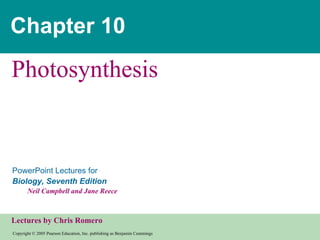Chapter 10(2)
•Télécharger en tant que PPT, PDF•
0 j'aime•308 vues
Photosynthesis is the process by which plants, algae, and some bacteria use sunlight, water and carbon dioxide to produce oxygen and energy in the form of glucose. It occurs in two stages - the light-dependent reactions and the light-independent Calvin cycle. The light reactions convert solar energy to chemical energy in the form of ATP and NADPH. These energy carriers are then used in the Calvin cycle to incorporate carbon from carbon dioxide into organic molecules to form glucose or other carbohydrates. Photosynthesis is essential as it produces oxygen and food for all living organisms.
Signaler
Partager
Signaler
Partager

Recommandé
Contenu connexe
Tendances
Tendances (20)
mechanism of photosysthesis PPT, SSC AP srinivas nallapu

mechanism of photosysthesis PPT, SSC AP srinivas nallapu
Ph0tosystemPhotosystem: Reaction center surrounded by several light-harvestin...

Ph0tosystemPhotosystem: Reaction center surrounded by several light-harvestin...
En vedette
En vedette (20)
Similaire à Chapter 10(2)
Similaire à Chapter 10(2) (20)
Organisms can be classified by how they get their energy and carbon- A (1).pdf

Organisms can be classified by how they get their energy and carbon- A (1).pdf
Photosynthesis in Higher Plants Class 11 Free Study Material PDF

Photosynthesis in Higher Plants Class 11 Free Study Material PDF
Plus de ktanaka2
Plus de ktanaka2 (13)
Chapter 10(2)
- 34. A Photosystem: A Reaction Center Associated with Light-Harvesting Complexes